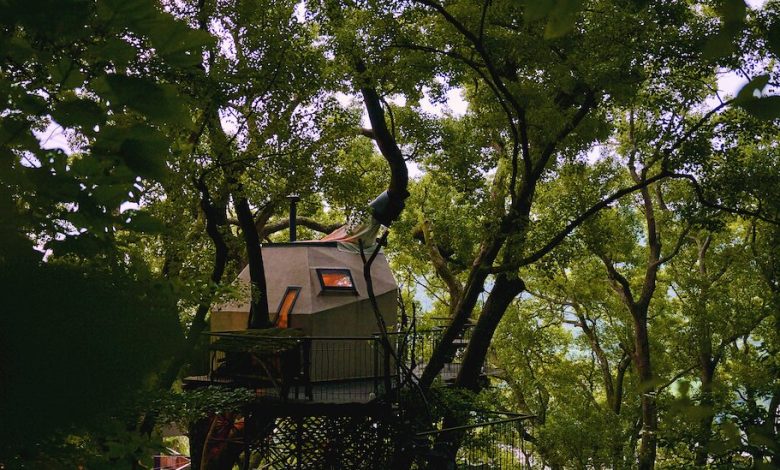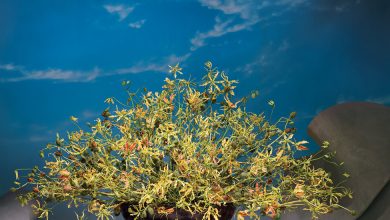A Treehouse Builder Who Celebrates Impermanence

“CAN YOU FEEL it swaying?” Takashi Kobayashi asks, 30 feet or so up a camphor tree growing in the cramped back lot of a shop in Tokyo. The wind theoretically shouldn’t be a factor, as we are hemmed in by buildings on all sides, but this tree, some 60 years old, has strained skyward in search of sunlight. With its canopy cresting the surrounding rooflines, its uppermost leaves catch the wind and everything below gently moves. The sensation is a bit unnerving and invokes one of the laws of treehouse building: Heights you wouldn’t think twice about in a concrete structure suddenly become imposing when you’re on a branch.
Taka, as everyone calls him — or sometimes Koba-san — is Japan’s best-known treehouse builder. He’s designed and constructed about 250 of them, ranging from backyard follies to a monumental work in response to the 2011 tsunami to a jungle perch with views of Angkor Wat in Cambodia (created for a commercial for the Japanese lottery). He’s built treehouses for affluent Chinese clients and treehouses for preschools — draws for parents anxious about their children’s detachment from nature. The arrival of Covid-19, which at once enhanced the appeal of private gathering spaces and catalyzed a renewed interest in being outside, has only made him and his company, Treehouse Creations, busier. The most modest of his structures, he says, is four square feet; the largest, about 270 square feet. He’s sometimes referred to as a “treehouse architect,” but he doesn’t care for the phrase — “architect” connotes not only degrees and building codes but other constraints, too, like permanence.

Kobayashi leaves gaps in his constructions, such as Dragon’s Nest, pictured here, so that the trees have room to grow.Credit…Josh Robenstone
Given all this, it’s a little startling when he also admits to a fear of heights. But “on land, if you try to build something, there are so many rules,” he says. “Building a treehouse, there’s a lot of freedom.”
The treehouse he’s currently building — at the moment just a collection of foundational hinoki cypress beams supported by struts — is behind a four-story store called Biotop, in Shirokanedai, one of Tokyo’s wealthier districts, marked by its comparatively low skyline and leafy streets. The shop is a curious mixture of cutting-edge fashion and natural skin-care products, enveloped by the teeming greenery of a nursery and topped by an airy cafe. Fourteen years ago, Biotop’s owner asked Kobayashi to build a small treehouse. Now he’s returned to rebuild it on a slightly larger scale, the idea being that cafe patrons might even eat their lunch there.
Kobayashi, who is 65, is small, lithe and sure-footed, with a watchful demeanor. He has the rugged looks of a lifelong surfer, even if a lingering shoulder injury (“from a bad chain saw,” he says) has diminished his winter outings — it’s too painful to get wet suits on and off. Today, he perches on a limb, pointing at a gouge etched in the side of the camphor marking the edge of the former treehouse. The tree had grown around the intruding plank, which Kobayashi has since removed. The limb is fatter below the gouge, as if what he’d built before, acting as a compress, had interrupted the flow of nutrients. He seems pained by this, pointing out that you have to respect the tree. “Because even if a treehouse dies,” he says, “a tree is still going to be alive.”
Houses settle over time because of gravity and minor tectonics, but trees, explains Kobayashi, will pull things apart. What distinguishes treehouse building from most other architecture is the need to accept a certain amount of imperfection: “They have to be a bit loose. If it’s built like a carpenter [would construct it], it’s going to crack open.” He doesn’t like to use blueprints or 3-D models, and he leaves gaps around the structure so the tree can continue to grow unimpeded. Still, a treehouse needs to remain in position — builders like Kobayashi rely on what are known as tree attachment bolts and dynamic uplift arrestors that penetrate the wood without splitting it and, more important, allow some flex, like small shock absorbers.
Kobayashi’s works, which often feature gnarled branches and unusually patterned shingles, tend toward the rustic and playful, evoking avian nests or the landscapes of J.R.R. Tolkien’s Lothlórien. His whole endeavor seems grounded in the Japanese concept of wabi-sabi — a characterization he doesn’t resist. As Leonard Koren, an artist who has written extensively on aesthetics, argues, the term, which is central and specific to the country, has become denuded by cliché but nonetheless represents a “comprehensive and clearly recognizable aesthetic universe.” Wabi-sabi, writes Koren in his 1994 book of the same name, includes “materials that are visibly vulnerable to the effects of weathering and human treatment,” and things that “often appear odd, misshapen, awkward.” Perhaps most critically, “wabi-sabi is an aesthetic appreciation of the evanescence of life.”
And treehouses are by their nature ephemeral. While many architects like to imagine their work existing for centuries, Kobayashi spends his time building spaces he knows won’t survive him. (This isn’t so unusual in Japan, where, as the architect Alastair Townsend has written in ArchDaily, for various reasons, including the need to constantly retrofit structures for earthquake resilience, “after 15 years, a home typically loses all value and is demolished on average just 30 years after being built.”) The life of a treehouse, Kobayashi says, is generally somewhere around 10 years. “It’s not going to last like stone,” he says. “And I want it that way.”
THEIR HOLD ON our imagination is more enduring. Treehouses stir some primordial instinct; the protohuman Australopithecus erected night nests in trees. Our shoulders seem built for brachiation, and the human hand today, with its ridged palms and the ability to grasp between the thumb and first digit, still bears the traces, notes Frank R. Wilson in “The Hand: How Its Use Shapes the Brain, Language and Human Culture” (1998), of an evolutionary move that “permitted improved climbing and locomotion along trunks and branches.” The publication in German, in 1813, of the novel “The Swiss Family Robinson” — about a family marooned on a remote isle — sparked the first modern vogue for treehouses. With industrialization, they came to stand as a sort of symbol for the lost vitality of our engagement with the natural world.
Not so long ago, Kobayashi tells me, treehouses were almost unheard-of in Japan. This itself is something of a surprise in a nation that’s among the most forested in the world; where houses were, until the war, usually made of wood; where trees have long been objects of social and religious importance; where, as folklore has it, the trees are inhabited by kodama, or spirits (as depicted in the 1997 film “Princess Mononoke”); where the term shinrin-yoku, or “forest bathing,” was invented.
I ask him about the Swiss Family Treehouse at Tokyo Disneyland, which opened in 1993. “That is made of concrete,” he replies. The sort of structure that marked my American suburban childhood, a rustic box nailed to an oak tree, was impossibly exotic here. Even in Tokyo, whose density, or what the authors of “Made in Tokyo” (2001), a seminal and offbeat architectural study of “nameless and strange buildings of this city,” call “void phobia,” has encouraged frenetic architectural experimentation — food courts built in railway embankments, tennis courts atop expressway tunnels — no one had seen fit to squeeze a treehouse into the urban fabric until Kobayashi did a few decades ago.
His route to becoming a treehouse builder was, by necessity, circuitous. Raised in the Izu Peninsula town of Shimoda, one of two ports that were opened to American vessels in 1854 following the arrival of Commodore Perry’s so-called black ships, Kobayashi says his coastal upbringing instilled in him an outward gaze. After a stint in television production, he fell into the vintage clothing market, and soon began traveling to the United States, where he’d trawl Goodwills, collecting garbage bags full of clothing he’d ship back to Japan. On buying trips between 1987 and 1993, Kobayashi came across a book on treehouses by the American arboreal architecture pioneer Pete Nelson, who’d go on to become the doyen of the field and the star of Animal Planet’s “Treehouse Masters.” Inspired, Kobayashi constructed a rustic treehouse in a Himalayan cedar outside his vintage clothes shop that he’d converted to a bar in the Tokyo neighborhood of Harajuku; it was a place he could read and leave behind city life. “I didn’t want to just build a treehouse,” he says. “I wanted the lifestyle that a treehouse represents.” Legally, his structure, called Escape, was a gray zone (it was eventually torn down by the landlord).
Not long after, when a Japanese magazine arranged for Nelson to fly to Japan and build a treehouse, Kobayashi insinuated himself into the proceedings. “Taka was determined to be my right-hand man,” says Nelson over the phone from his house on Washington’s San Juan Island, “but doesn’t speak a word of English and I didn’t know what to make of him because he wasn’t a carpenter.”
Seemingly through sheer force of will, Kobayashi made his name in what Nelson calls “this weird little business.” And his influence has spread: There’s now a treehouse resort on Okinawa Island and, in 2014, he was joined by the architect Hiroshi Nakamura and his Tokyo-based firm NAP, with support from the sustainable design consultancy Arup, on an elaborate treehouse in a 300-year-old camphor tree at the Hoshino Risonare resort in Atami, two hours southwest of Tokyo. Resting on a nestlike assemblage of hexagonally arranged metal rods, woven in and out of the tree — but never touching it — the 260-square-foot structure is topped by a small teahouse, another architectural form in Japan that offers a momentary respite from everyday life. “Treehouses are kind of like tea ceremony houses,” Kobayashi says. “They’re small, and you enter the room as equals.” That idea was taken to its logical conclusion by the architect Terunobu Fujimori in his 2004 Takasugi-an, a teahouse built atop tall chestnut trees. (Kobayashi finds Fujimori’s architecture beautiful, though he notes that that project used cut trees, moved from another location, as pillars and was not set within a living tree. He adds that Fujimori didn’t initially call the project a treehouse, “but apparently he calls them treehouses now.”)
Later, as we drink tea in Biotop’s cafe, I ask Kobayashi if he has any fantasy treehouse projects. “In Japan, all the big trees are in temples and shrines,” he says. Their sacred nature precludes any sort of tampering. Maybe, he says, the emperor would grant him special dispensation, and he could have his pick of this tree-adoring nation’s finest specimens. Failing that, there’s another revered figure he’s eager to build for: “I really like Keith Richards,” he says. “Hopefully I’ll get a commission.”
Locations photographed: Elevated Forest Base — Kusu Kusu at Hoshino Resorts Risonare Atami; treehouse at Huuran no Yakata; Fureai no Mori Satoyama Adventure Field (Park) Treehouse. Photo assistant: Hiroki Nagahiro. Production: Ayumi Konishi at Beige





